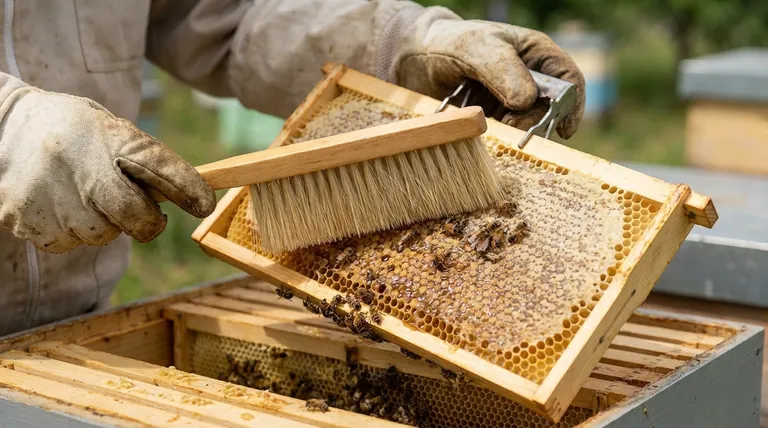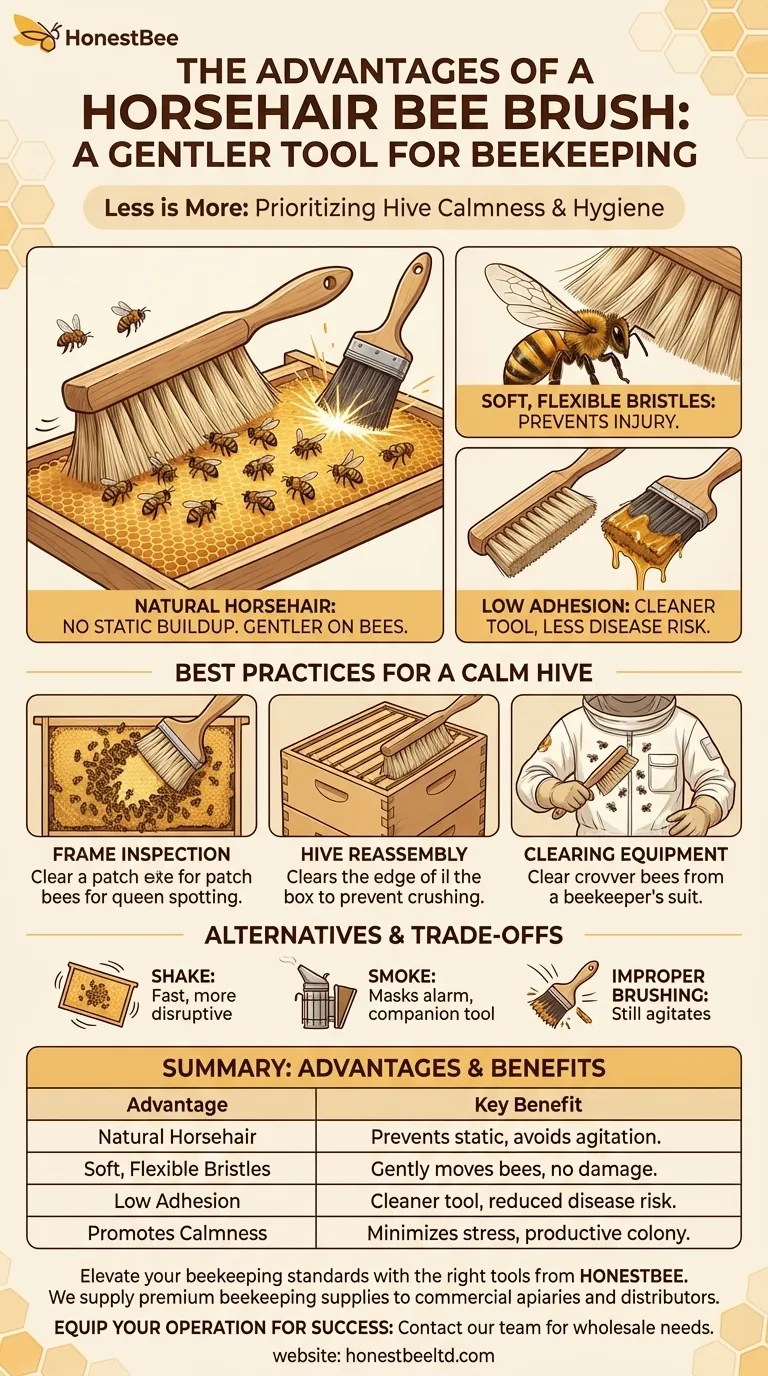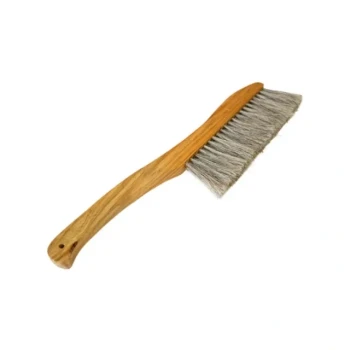In beekeeping, the right tool often does less, not more. A dedicated bee brush, specifically one made of natural horsehair, is a prime example of this principle. Its primary advantages are that it prevents the buildup of static electricity, making it significantly gentler on bees, and it collects less honey and propolis, keeping your work cleaner and reducing the risk of agitating the colony.
The purpose of a bee brush is not simply to move bees, but to do so with minimal stress to the colony. Its design, centered on natural fibers, directly supports hive calmness, reduces bee injury, and promotes better hive hygiene.

Why the Right Brush Matters for a Calm Hive
A calm hive is a productive and safe hive. The tools you use during an inspection play a significant role in maintaining that calm. The bee brush is specifically engineered to avoid triggering the bees' defensive responses.
Eliminating Static Agitation
Synthetic brushes, like those made of nylon or other plastics, generate static electricity as they move across surfaces. Bees can perceive this static charge as a threat, which can lead to agitation and stinging.
A brush made from natural horsehair does not create this static charge. This makes the interaction feel more natural and less alarming to the bees, keeping the colony's overall stress level down.
Preventing Injury with Soft Bristles
The goal is to gently persuade bees to move, not to force them. The long, soft bristles of a horsehair brush are flexible enough to usher bees aside without damaging their delicate wings or legs.
Using a harsh tool, or even your gloves, can easily crush bees or tear wings, which not only harms the individual bees but can also release alarm pheromones that put the entire colony on high alert.
Maintaining a Cleaner Tool and Hive
Bee brushes are designed to be less "sticky" than other implements. They pick up minimal amounts of honey and propolis during use.
This is critical for two reasons. First, a sticky tool is harder to use and more likely to roll or injure bees. Second, and more importantly, it reduces the risk of transferring diseases or pests from one hive to another.
Best Practices for Using a Bee Brush
Knowing when and how to use a brush is as important as having one. Its purpose is for targeted, gentle removal where other methods are too disruptive.
For Frame Inspection
The most common use is to clear a patch of bees from a frame of brood or honey. This allows you to get a clear view to check for the queen, eggs, larvae, or signs of disease without disturbing the entire frame population.
Use a gentle, sweeping motion, almost like painting, to guide the bees away from the area you need to see.
During Hive Reassembly
When you place a honey super or hive body back onto the hive, bees can get caught and crushed between the boxes.
A quick, gentle sweep of the brush along the edges of the box just before you set it down will clear the bees and prevent unnecessary casualties.
Clearing Bees from Your Equipment
Before you walk away from the apiary, it's wise to ensure no bees are clinging to your suit or veil. A bee brush is the perfect tool for gently whisking them off so they can return to their hive instead of following you.
Understanding the Alternatives and Trade-offs
A brush is an excellent tool, but it's not the only way to move bees. Understanding the alternatives helps you make the best choice in the moment.
The "Shake" Method
A short, sharp shake of a frame can dislodge most of the bees back into the hive. This is fast and effective but can be more disruptive than brushing, especially if done aggressively. It's often used when you need to clear a whole frame quickly, such as during a honey harvest.
A Puff of Smoke
A smoker doesn't physically move bees, but it is essential for masking the alarm pheromone bees release when they feel threatened. A gentle puff of smoke can often encourage bees to move down into the hive or consume honey, making them calmer and easier to manage. Smoke is a companion to brushing, not a replacement.
The Risk of Improper Brushing
The chief trade-off is that even a proper brush can be used too aggressively. Jabbing, swatting, or rapid brushing will still agitate the colony. The tool's effectiveness is entirely dependent on the beekeeper's gentle technique.
How to Apply This to Your Beekeeping
Choosing and using your tools correctly is a hallmark of a skilled beekeeper. Your decisions should always prioritize the health and stability of the colony.
- If your primary focus is a gentle, low-stress inspection: The horsehair bee brush is an indispensable tool for carefully examining frames and handling bees with precision.
- If your primary focus is efficiency during a honey harvest: A combination of a gentle shake to remove the bulk of the bees, followed by brushing off the stragglers, is the most effective workflow.
- If your primary focus is hive hygiene and disease prevention: Using a clean brush and avoiding cross-contamination between hives is a critical best practice.
Ultimately, a bee brush is more than a tool; it's a reflection of your commitment to working in harmony with your bees.
Summary Table:
| Advantage | Key Benefit |
|---|---|
| Natural Horsehair | Prevents static electricity buildup, avoiding bee agitation. |
| Soft, Flexible Bristles | Gently moves bees without damaging delicate wings or legs. |
| Low Honey/Propolis Adhesion | Keeps the tool cleaner and reduces disease transfer risk. |
| Promotes Hive Calmness | Minimizes stress, supporting a more productive and safer colony. |
Elevate your beekeeping standards with the right tools from HONESTBEE.
We understand that commercial apiaries and distributors need reliable, high-quality equipment to maintain healthy, productive colonies. A proper bee brush is a small but critical part of that toolkit. HONESTBEE supplies premium beekeeping supplies and equipment through our wholesale-focused operations, ensuring you have access to the gentle, effective tools that reflect a commitment to hive harmony.
Ready to equip your operation for success? Contact our team today to discuss your wholesale needs and discover how our products can support your beekeeping goals.
Visual Guide

Related Products
- Wooden Bee Brush with Triple Row Artificial Fiber for Beekeeping
- Classic Wooden Bee Brush with Double-Row Boar Bristles
- Double Row Artificial Fiber Bee Brush for Beekeeping
- Plastic Handle Single Row Artificial Fiber Bee Brush
- Premium Triple-Row Horsehair Bee Brush
People Also Ask
- What is the purpose of a bee brush? Gently Manage Your Hive with Precision
- What is a bee brush and what is its primary use? A Gentle Tool for Hive Management
- What are the key features of a popular bee brush? Essential Design for Bee Safety and Hive Hygiene
- How does using a bee brush benefit beekeepers and the hive? Achieve Gentle, Stress-Free Hive Management
- What is the purpose of a bee brush? Master Gentle Hive Management for Healthier Bees



















